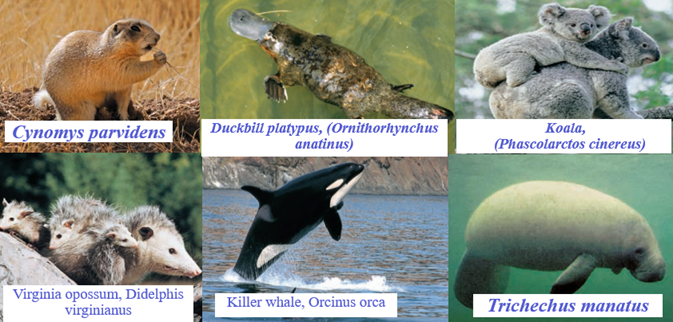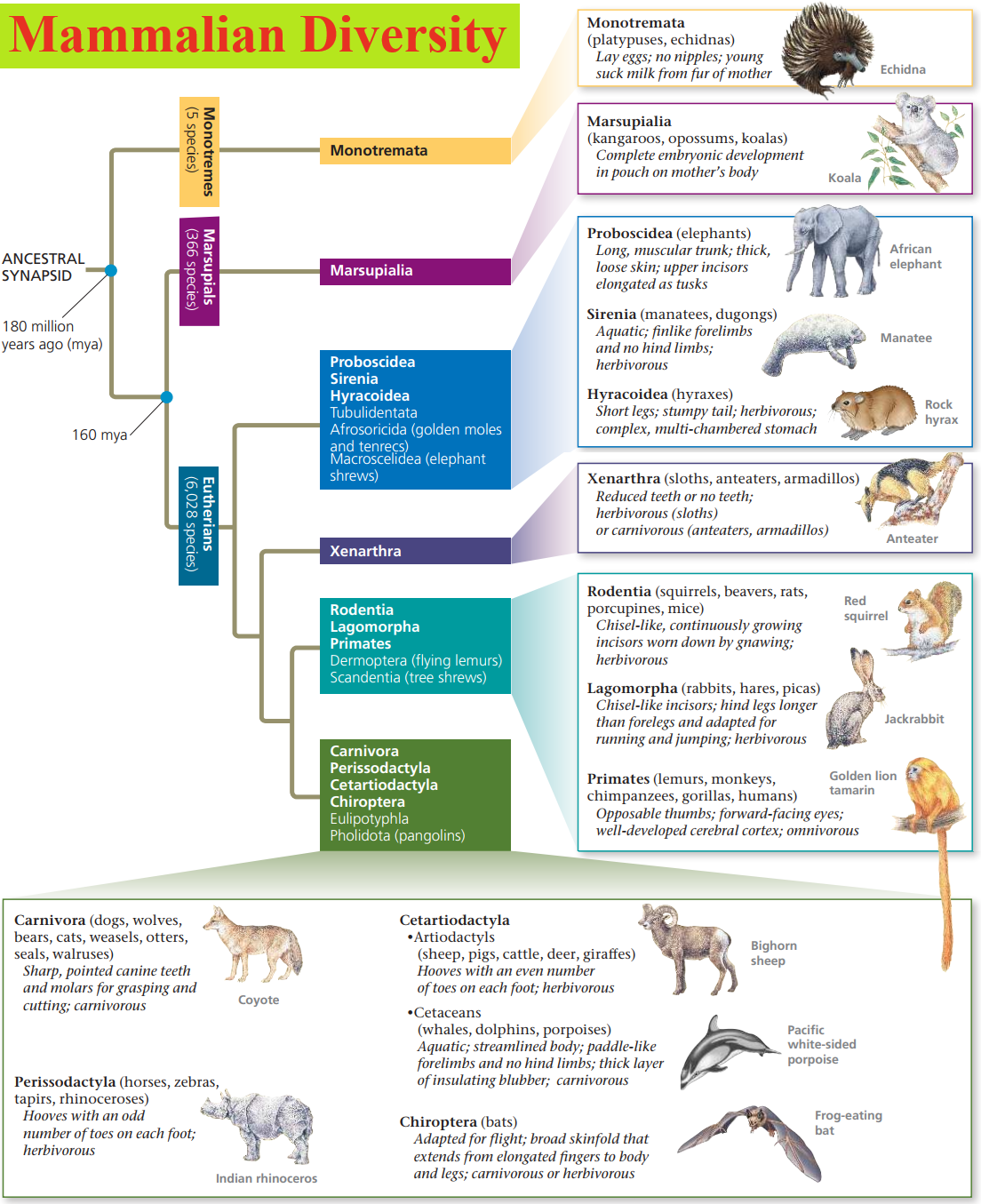Enlighten Biology note on the Diversity of Mammals

Enlighten Biology note on the Diversity of Mammals
MAMMALS
Mammals include the largest animal ever to live, the blue whale (130 metric tons).
The smallest mammal, the Kitti’s bat (1.5 g)
And the fastest land animal is the cheetah (110 km/hr).
These characteristics distinguish mammals:
- Mammals are named for their distinctive mammary glands, which produce milk for offspring.
- All mammalian mothers nourish their young with milk, a balanced diet rich in fats, sugars, proteins, minerals, and vitamins.
- Hair, another mammalian character, and a fat layer under the skin provide insulation that can conserve water and protect the body against extremes of heat or cold.
- The colour of hair can camouflage a mammal and help the animal blend into its surroundings.
- In addition, hair can be ornamental and can serve sensory functions.
- Another mammalian adaptation for life on land is the kidney, which is efficient at conserving water when removing wastes from the body.
- Some mammals, such as kangaroo rats, are so adept at conserving water that they can survive in arid environments while drinking little or no water at all.
- Like birds, mammals are endothermic, and most have a high metabolic rate.
- Efficient respiratory and circulatory systems (including a four-chambered heart) support a mammal’s metabolism.
- Also as in birds, mammals generally have a larger brain than other vertebrates of equivalent size, and many species are capable learners.
- The relatively long duration of parental care extends the time for offspring to learn important survival skills by observing their parents.
- In addition, whereas the teeth of reptiles are generally uniform in size and shape, the jaws of mammals typically bear a variety of teeth with sizes and shapes adapted for chewing many kinds of foods.
- Humans, like most mammals, have teeth modified for steering (incisors and canine teeth) and for crushing and grinding (premolars and molars).
- In most mammals, the young are born alive after a period of development in the uterus, a part of the female reproductive tract.
- Internal development shelters the young and allows the female to move actively about while the young are maturing.
Evolution of Mammals
Mammals belong to a group of amniotes known as synapsids.
Early nonmammalian synapsids lacked hair, had a sprawling gait, and laid eggs.
A distinctive characteristic of synapsids is the single temporal fenestra, a hole behind the eye socket on each side of the skull.
Humans retain this feature; your jaw muscles pass through the temporal fenestra and anchor on your temple.
Fossil evidence shows that the jaw was remodeled as mammalian features arose gradually in successive lineages of earlier synapsid.
In all, these changes took more than 100 million years.
In addition, two of the bones that formerly made up the jaw joint (the quadrate and the articular) were incorporated into the mammalian middle ear.
This evolutionary change is reflected in changes that occur during development.
For example, as a mammalian embryo grows, the posterior region of its jaw which in a reptile forms the articular bone, can be observed to detach from the jaw and migrate to the ear, where it forms the malleus.
Synapsids evolved into large herbivores and carnivores during the Permian period (299–252 million years ago), and for a time they were the dominant tetrapods.
However, the Permian-Triassic extinctions took a heavy toll on them, and their diversity fell during the Triassic (252–201 million years ago).
Increasingly mammal-like synapsids emerged by the end of the Triassic.
While not true mammals, these synapsids had acquired a number of the derived characters that distinguish mammals from other amniotes.
They were small and probably hairy, and they likely fed on insects at night.
Their bones show that they grew faster than other synapsids, suggesting that they probably had a relatively high metabolic rate however, they still laid eggs.
During the Jurassic (201–145 million years ago),
The first true mammals arose and diversified into many short-lived lineages.
A diverse set of mammal species coexisted with dinosaurs in the Jurassic and Cretaceous periods, but most of these species were small, measuring less than 1 m in length.
One factor that may have contributed to their small size is that dinosaurs already occupied many ecological niches of large-bodied animals.
Fossil and molecular evidence indicate that by 160 million years ago, the three major lineages of mammals had emerged, those leading to;
- monotremes (egg-laying mammals),
- marsupials (mammals with a pouch),
- and eutherians (placental mammals).
After the extinction of large dinosaurs, pterosaurs, and marine reptiles during the late Cretaceous period, mammals underwent adaptive radiation, giving rise to large predators and herbivores as well as flying and aquatic species.
Monotremes
Monotremes are egg-laying mammals that include only the duckbill platypus and two species of spiny anteaters.
The term monotreme refers to the presence of a single opening, the cloaca.
Monotremes unlike other mammals lay hard-shelled amniotic eggs.
No embryonic development occurs inside the female’s body.
The female duckbill platypus lays her eggs in a burrow in the ground.
She incubates the eggs, and after hatching, the young lick up milk that seeps from modified sweat glands on the mother’s abdomen.
Spiny anteaters, which feed mainly on termites and not ants, have pores that seep milk in a shallow belly pouch formed by skin folds on each side.
The egg moves from the cloaca to this pouch, where hatching takes place and the young remain for about 53 days.
Then they stay in a burrow, where the mother periodically visits and nurses them.
Like all mammals, monotremes have hair and produce milk, but they lack nipples.
Milk is secreted by glands on the belly of the mother.
After hatching, the baby sucks the milk from the mother’s fur.
Marsupials
Opossums, kangaroos, and koalas are examples of the group called marsupials.
Both marsupials and eutherians share derived characters not found among monotremes.
They have higher metabolic rates and nipples that provide milk, and they give birth to live young.
The embryo begins development inside the uterus of the female’s reproductive tract.
The lining of the uterus and the extraembryonic membranes that arise from the embryo form a placenta, a structure in which nutrients diffuse into the embryo from the mother’s blood.
A marsupial is born very early in its development and completes its embryonic development while nursing.
In most species, the nursing young are held within a maternal pouch called a marsupium.
A red kangaroo, for instance, is about the size of a honeybee at its birth, just 33 days after fertilization.
Its back legs are merely buds, but its front legs are strong enough for it to crawl from the exit of its mother’s reproductive tract to a pouch that opens to the front of her body, a journey that lasts a few minutes.
In other species, the marsupium opens to the rear of the mother’s body; in greater bilbies, this protects the young as their mother burrows in the dirt.

Eutherians (placental mammals)
Eutherians are commonly called placental mammals because their placentas are more complex than those of marsupials.
They have a longer pregnancy than marsupials.
Young eutherians complete their embryonic development within the uterus, joined to their mother by the placenta.
The eutherian placenta provides an intimate and long-lasting association between the mother and her developing young.
The major groups of living eutherians are thought to have diverged from one another in a burst of evolutionary change.
The timing of this burst is uncertain: Molecular data suggest it occurred about 100 million years ago, while morphological data suggest it was about 60 million years ago.
Placental mammals lead an active life.
The senses are acute, and the brain is enlarged due to the convolution and expansion of the foremost part of the cerebral hemispheres.
The brain is not fully developed for some time after birth, and there is a long period of dependency on the parents, during which the young learn to take care of themselves.
Most mammals live on land, but some (e.g., whales, dolphins, seals, sea lions, and manatees) are secondarily adapted to live in water, and bats can fly.
While bats are the only mammals that can fly, three types of placentals can glide:
- the flying squirrels,
- scaly-tailed squirrels,
- and the flying lemurs.
These are the main types of placental mammals:
Ungulates
- The ungulates are hoofed mammals, which comprise about a third of all living and extinct mammalian groups.
- The hoofed mammals have a reduced number of toes and are divided according to whether an odd number remains (e.g., horses, zebras, tapirs, rhinoceroses) or whether an even number of toes remain (e.g., pigs, cattle, deer, hippopotamuses, buffaloes, giraffes).
- Many of the hoofed animals have elongated limbs and are adapted for running, often across open grasslands.
- Both groups of animals are herbivorous and have large, grinding teeth.
Carnivores
- The carnivores (e.g., dogs, cats, bears, raccoons, and skunks) are predaceous meat eaters with large and conical-shaped canine teeth.
- Some carnivores are aquatic (e.g., seals, sea lions, and walruses) and must return to land to reproduce.
Primates
- The primates are tree-dwelling fruit eaters (e.g., lemurs, monkeys, gibbons, chimpanzees, gorillas, and humans).
- Humans are ground dwellers, well known for their opposable thumbs and well-developed brains.
Cetaceans
- The Cetaceans are well-known marine whales and dolphins, which have very little hair or fur.
- Baleen whales feed by straining large quantities of water containing plankton.
- Toothed whales feed mainly on fish and squid.
Chiroptera
- The Chiroptera are the flying mammals (e.g., bats), whose wings consist of two layers of skin and connective tissue stretched between the elongated bones of all fingers but the first.
- Many species use echolocation to navigate at night and to locate their usual insect prey.
- But there are also birds, fish, frogs, plants, and blood-eating bats.
Rodents
- The rodents are most often small plant eaters (e.g., mice, rats, squirrels, beavers, and porcupines).
- The incisors of these gnawing animals suffer heavy wear and tear, and they grow continuously.
Proboscideans
- The proboscideans, the herbivorous elephants, are the largest living land mammals, whose upper lip and nose have become elongated and muscularized to form a trunk.
Lagomorphans
- The lagomorphans are the rodentlike jumpers (e.g., rabbits, hares, and pikas).
- These herbivores have two pairs of continually growing incisors, and their hind legs are longer than their front legs.
Insectivores
- The insectivores are small burrowing mammals (e.g., shrews and moles), which have short snouts and live primarily underground.
At one time, it was thought that insectivores were most like the original placentals.
More recent analysis suggests that the edentates (anteaters) and pangolins (scaly anteaters) are the more primitive groups of living placentals
Join Enlighten Knowledge WhatsApp platform.
Join Enlighten Knowledge Telegram platform.





